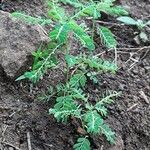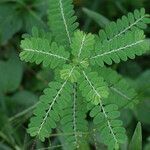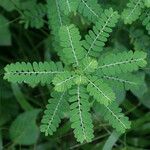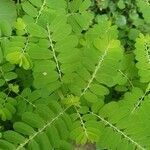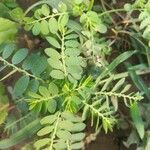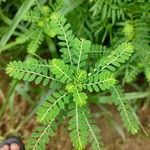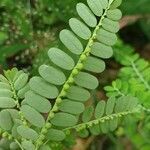Annual herb, glabrous, erect, 1-5 dm high; monoecious; main stem smooth, terete, usually 1.5-2 mm thick; scale-leaves scarious, brownish, 1-2 mm long. Deciduous branchlets 4-12 cm long, ca 0.5 mm thick, subterete (never sharply winged), smooth or proximally roughened, with ca 15-30 leaves. Leaves thin; petioles 0.3-0.5 mm long; stipules lanceolate, 0.8-1.3 mm long; blades elliptic-oblong or somewhat obovate, mostly 5-11 mm long and 3-6 mm broad, rounded to apiculate at the tip, only slightly (if at all) inaequilateral at base, the margins smooth or obscurely roughened. Cymules mostly bisexual, the proximal 1 or 2 axils with staminate flowers, the other axils each with one staminate and one pistillate flower. Staminate flowers with pedicels 0.6-1.3 mm long; calyx-lobes 5 (rarely 6), ovate or elliptic, 0.3-0.6 mm long; disc-segments 5, entire; stamens 3 (rarely 2), the filaments connate into a column 0.2-0.3 mm high, the anthers dehiscing obliquely or horizontally; pollen grains 3-colporate. Pistillate flowers with pedicels becoming 1-2 mm long in fruit; calyx-lobes usually 5, obovate-oblong, acute or apiculate, becoming 0.9-1 mm long; disc flat, deeply 5-lobed, some-times irregular; ovary smooth, the styles free, ascending, shallowly bifid, less than 0.2 mm long. Capsules smooth, stramineous, 1.9-2.1 mm in diam; seeds sharply trigonous, light brown, 0.9-1 mm long, with 5 or 6 straight parallel ribs on the back.
Herbs, annual, monoecious, 1–5 dm; branching phyllanthoid. Stems: main stems terete, not winged, glabrous; ultimate branchlets subterete, not winged, glabrous or slightly scabridulous proximally. Leaves on main stems spiral, scalelike; stipules not auriculate, pale brown. Leaves on ultimate branchlets distichous, well developed; stipules not auriculate, pale green with pale brown margins; blade elliptic-oblong to obovate, 5–11 × 3–6 mm, base obtuse or rounded, apex obtuse to rounded, often apiculate, both surfaces glabrous. Inflorescences cymules or flowers solitary, proximal staminate with 1–2 flowers, distal bisexual with 1 pistillate flower and 1 staminate flower. Pedicels: staminate 0.6–1.3 mm, pistillate spreading in fruit, (1–)1.2–2 mm. Staminate flowers: sepals 5(–6), pale green, flat, 0.3–0.6 mm; nectary extrastaminal, 5 glands; stamens (2–)3, filaments connate throughout. Pistillate flowers: sepals (5–)6, green with broad pale green to white margins, flat, 0.8–1.1 mm, 1-veined; nectary annular, 5(–7)-lobed. Capsules 1.9–2.1 mm diam., smooth. Seeds uniformly brown, 0.9–1 mm, longitudinally ribbed. 2n = 52 (Jamaica).
Female flowers: pedicels c. 1 mm long, extending to 1.5 mm in fruit, apically thickened; sepals 5, 0.75–1 × 0.3–0.5 mm, not or slightly accrescent in fruit, ovate-oblong, subacute, greenish with white margins; disk c. 0.5 mm across, flat, 5-lobed, the lobes triangular, basally lobulate or not; ovary 0.3 mm in diameter, subsessile, subglobose, smooth; styles 3, 0.1 mm long, free, suberect, later ± spreading, 2-lobed.
Male flowers: pedicels 1 mm long; sepals 5, 0.6 × 0.5 mm, ovate, acute, pale greenish-cream; disk glands 5, free, minute, lobulate; stamens 3, filaments connate into a column c. 0.4 mm high, anthers 0.25 mm across, sessile, vertical, 2 bithecate, reniform, obliquely dehiscent with confluent slits, 1 monothecate.
An annual herb. It grows 10-40 cm high. It almost lies along the ground. It is woody near the base. The leaves are in one plain. The flowers hang from one side of the branch. Flowers are separately male and female. The fruit is round and flattened. It splits into three. The seeds have ribs.
Seeds 0.8–1 × 0.6–0.8 × 0.5–0.7 mm, segmentiform, light brown, with 5–7 longitudinal ridges on the dorsal facet, and 4–6 irregularly concentric ridges on each ventral facet, with innumerable faint transverse striae between them.
Leaf blades 5–10 × 2–5 mm, mostly oblong, rounded-subtruncate at apex and base, membranaceous, dull green above, paler beneath; lateral nerves in 4–6 pairs, looped at the apex, inconspicuous above, not prominent beneath.
Scale leaves 1–1.3 mm long, linear-subulate, blackening at the apex; stipules 1.5 × 1 mm, broadly triangular-lanceolate, asymmetrical at the base, dark brown.
Foliage leaves distichous; petioles 0.3–0.5 mm long; stipules 1 mm long, linear-lanceolate, cream-coloured with a brownish midrib.
Male and female flowers often occurring together in the distal axils, female flowers usually solitary in the proximal axils.
A glabrous erect or ascending annual herb up to 75 cm tall, sometimes woody at the base, monoecious or rarely dioecious.
Lateral shoots up to c. 15 cm long, the older ones usually co-axillary with secondary lead shoots.
Fruit 1–1.2 × 1.5–2 mm, oblate, smooth, ochreous-olivaceous.
A glabrous herb with slender subwoody stems
Lead shoots terete.
A weed.
